Tripura is undoubtedly one of the most fascinating states of India. Located in north-eastern India, it was called Kirata Desh or land of the Kirata in Mahabharata. The origin of the name Tripura is often linked with the Goddess Tripura Sundari, one of the state’s most esteemed deities. But, in all probability, the name ‘Tripura’ originates from ‘Tipra’, ‘Tippera’, and ‘Tuipura’, which denote the state’s indigenous population.
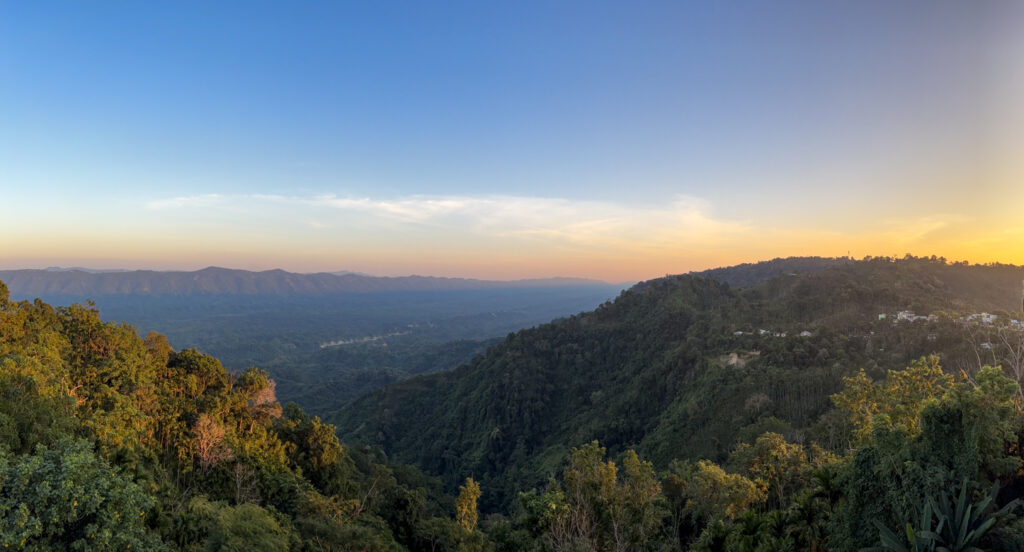
Like the other northeastern states of India, Tripura has a sizeable tribal population. There are 19 tribes residing here, thus making Tripura a culturally rich and diverse state. Tripura also boasts unique archaeological sites, such as Unakoti, Chabimura, and the Buddhist site of Pilak. In addition, the natural beauty of Tripura is exceptional, thanks to the Jampui Hills, Gomati River, and an array of pristine lakes.

We covered the entire Tripura (except Pilak) within 7 days. Here goes our 7-day itinerary for travelling to this gem of the north-east.

Table of Contents
Day 1: Reaching Agartala and exploring the capital:
The flight from Kolkata takes less than an hour to reach Agartala, Tripura’s capital city. At first glance, Agartala resembled a nondescript town in north Bengal. With locals conversing mostly in Bengali and the shop hoardings’ being displayed in Bengali, it did not feel like we had just arrived in a completely new state.
We checked in at Hotel Tripura Sundari, which lies just beside the Agartala rail station. Since we had an early morning train to catch, we decided to stay near the rail station instead of the main city area. The hotel is a basic one, although the rooms are spacious, clean, and provided with all amenities. The price of double rooms is INR 1100, while single rooms are INR 800. You need to bargain a bit to get a lower price.
Afterwards, we swiftly showered, got dressed, grabbed a quick lunch at the nearby Sanskar Restaurant (the food is absolutely lip-smacking here), and set out to explore Agartala. For venturing within Agartala, e-rickshaws and autos are the best options. We hired an e-rickshaw for INR 500 for the entire day.
1. Ujjayanta Palace:
We first visited the splendid Ujjayanta Palace. The pristine Palace was built by Maharaja Radha Kishore Manikya in 1901 and named by Nobel laureate Rabindranath Tagore. Situated at the heart of Agartala, it was designed by Sir Alexander Martin in a Neo-classical style. The architectural style is influenced by Roman, Mughal, and British styles.


The Ujjayanta Palace used to be the residence of the royal family of Tripura. Covering an area of around 250 acres, the palace has a throne room, durbar hall, library, and other rooms. Later, after independence, the palace served as the State Legislative Assembly until 2011. At present, the Ujjayanta Palace has been converted into a vast museum, which showcases the history, geography, heritage, and culture of Tripura.

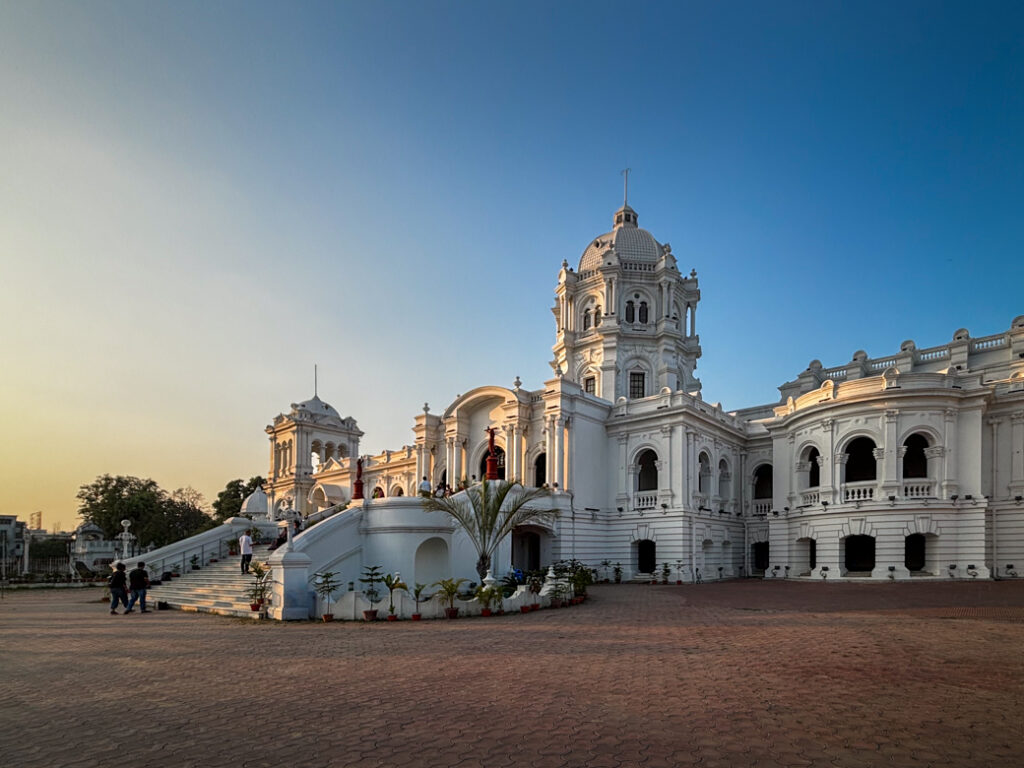
Things to remember while visiting Ujjayanta Palace:
- The palace remains open from 10-15 AM to 5-15 PM.
- It remains closed on Mondays and Govt. holidays.
- The entry fee for domestic tourists is INR 40 per person, INR 100 for Bangladeshi tourists, and INR 250 for foreign tourists.
- Entry is free for children below 10 years and school students on excursion trips with uniforms.
- Professional still camera charge is INR 600 per camera and INR 1500 for professional video cameras.
- Light and sound show is also held here daily. There are two shows – the first from 6-30 PM to 7 PM, and the second one from 7-30 PM to 8 PM. The entry fee for adults is INR 100 and for children below 10 years is INR 50.
Pro tip – Try visiting after 3 PM, as the palace looks spectacular under the afternoon sun.
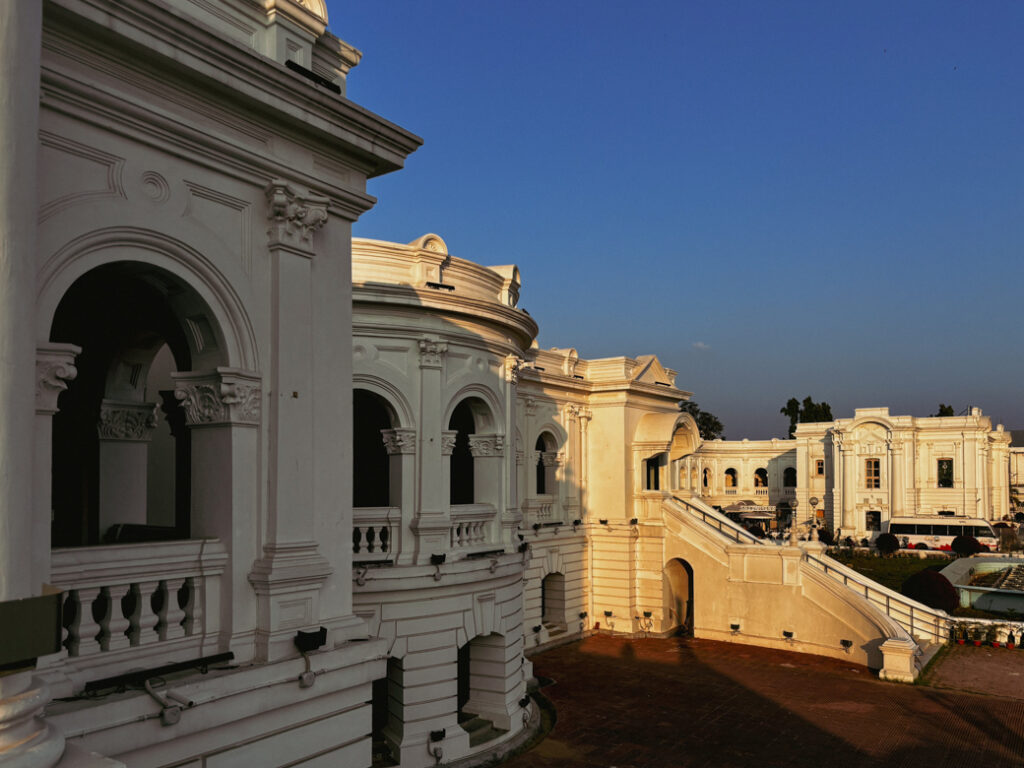
2. Lakshmi Narayan Temple:
This beautiful temple was built by Maharaja Birendra Kishore Manikya. Dedicated to Narayan and Lakshmi, it lies in the Ujjayanta Palace premises. Sadly, the temple was closed when we visited.
3. Durga Bari:
Located just beside the Ujjayanta Palace, the temple is consecrated to Goddess Durga. The Durga Puja is celebrated with huge fanfare here. Interestingly, the Goddess here has two hands instead of her usual ten hands.


4. Jagannath Bari:
This temple was built by Maharaja Radha Kishore Manikya in the 19th century. The temple is now managed by Sri Chaitanya Goudiya Math. Here, Lord Jagannatha is worshipped along with his siblings, Balabhadra and Subhadra. The entrance of the temple is modelled after the ‘Ratha’ or chariot of Jagannatha. The temple premise has beautiful idols of Sri Krishna, Sri Rama, Lakshmi – Narayan, Siva -Parvati, and Sri Chaitanya Mahaprabhu.


The Jagannath Bari also offers accommodation to pilgrims and tourists. You can contact them at 0381 – 2324497/9774034517.
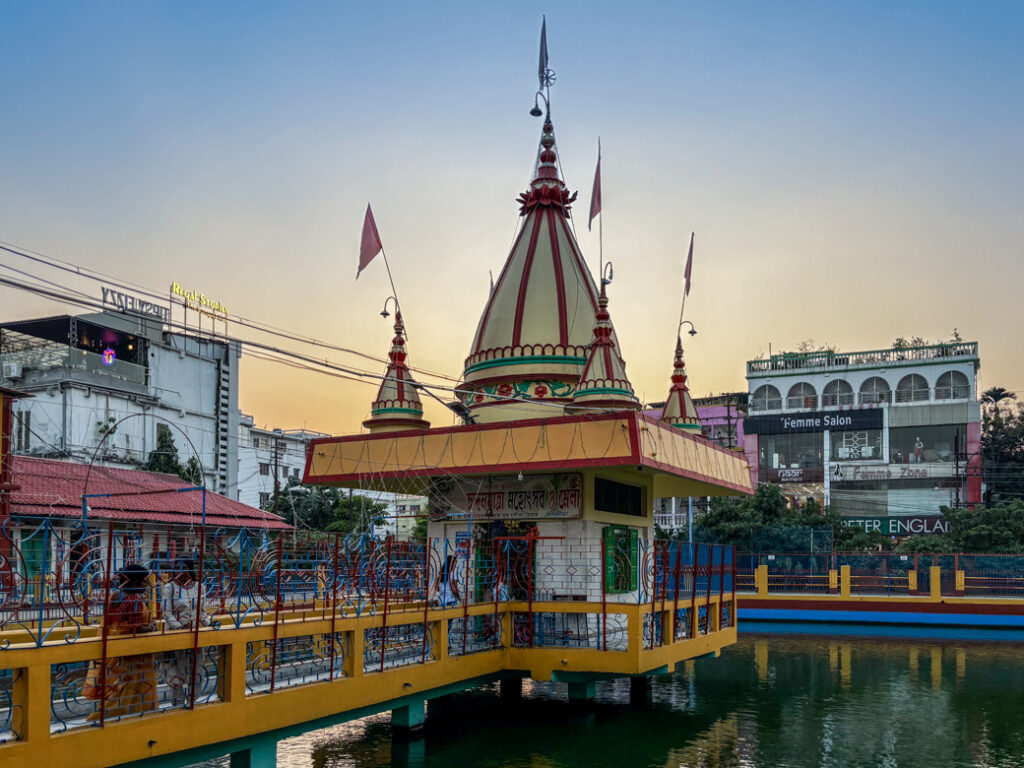
Later, we explored the roadside food joints near Ujjayanta Palace. Countless food stalls start operating here after 5 PM. You can find chats and panipuris, momo and soups, rolls and chowmein, chop and beguni, as well as Tripuri delicacies such as Tohan Mosdeng and Wahan Mosdeng. The place looks like a small fair during the evening.
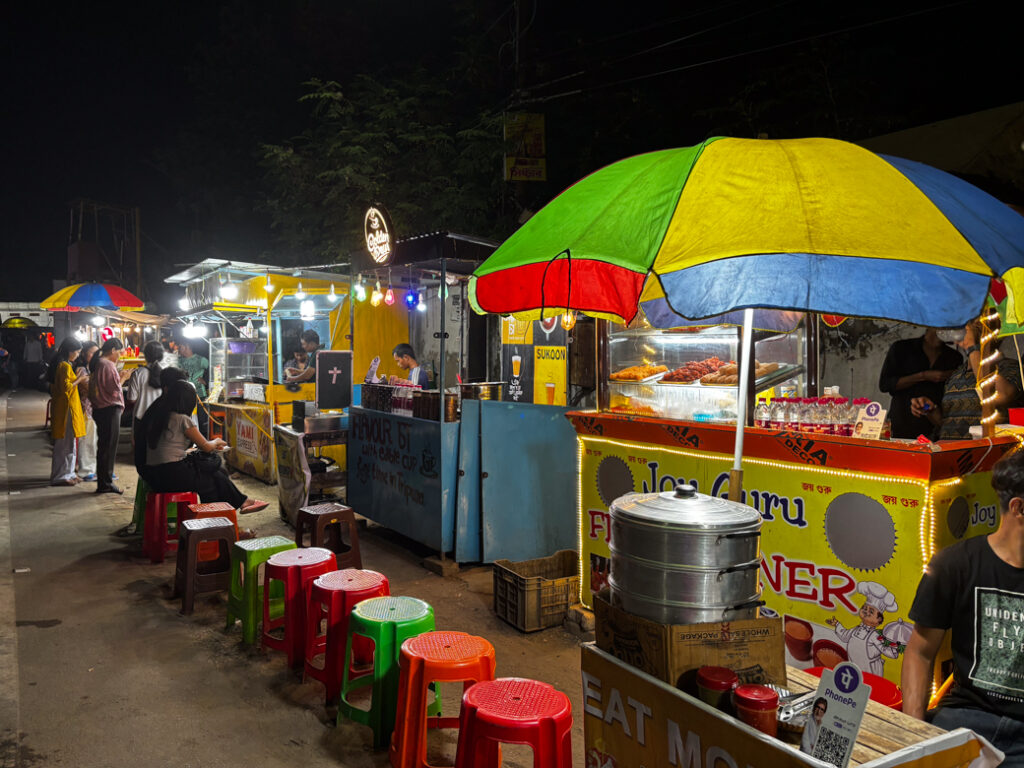
Day 2: Exploring a temple, a zoo, and a border check post:
1. Kasba Kali Temple, Kamala Sagar:
The second day being the Kali Puja and Diwali, we started by paying a visit to the revered Kasba Kali Temple. Situated just beside the international border of Bangladesh, this temple was built by Maharaja Dhana Manikya in the 15th century. He also commissioned the digging of the picturesque Kamala Sagar just beside the temple premises.

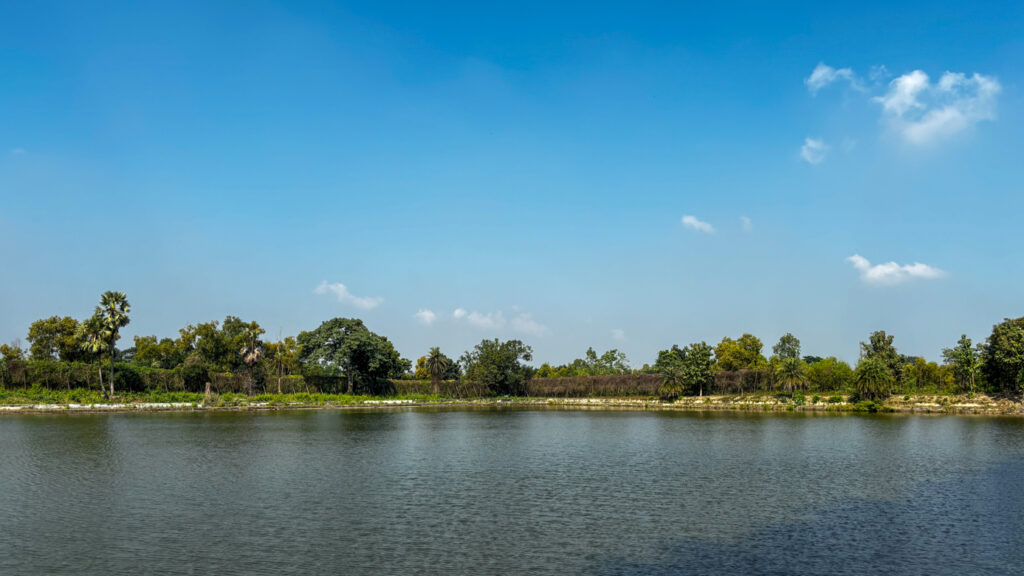
Though the idol is worshipped as Kasbeshwari Kali, it actually depicts the ten-handed Durga slaying the buffalo demon, Mahisasura. Surprisingly, the base platform has an image of Siva.

The temple has a serene atmosphere, and the darshan and Puja offerings go here smoothly.
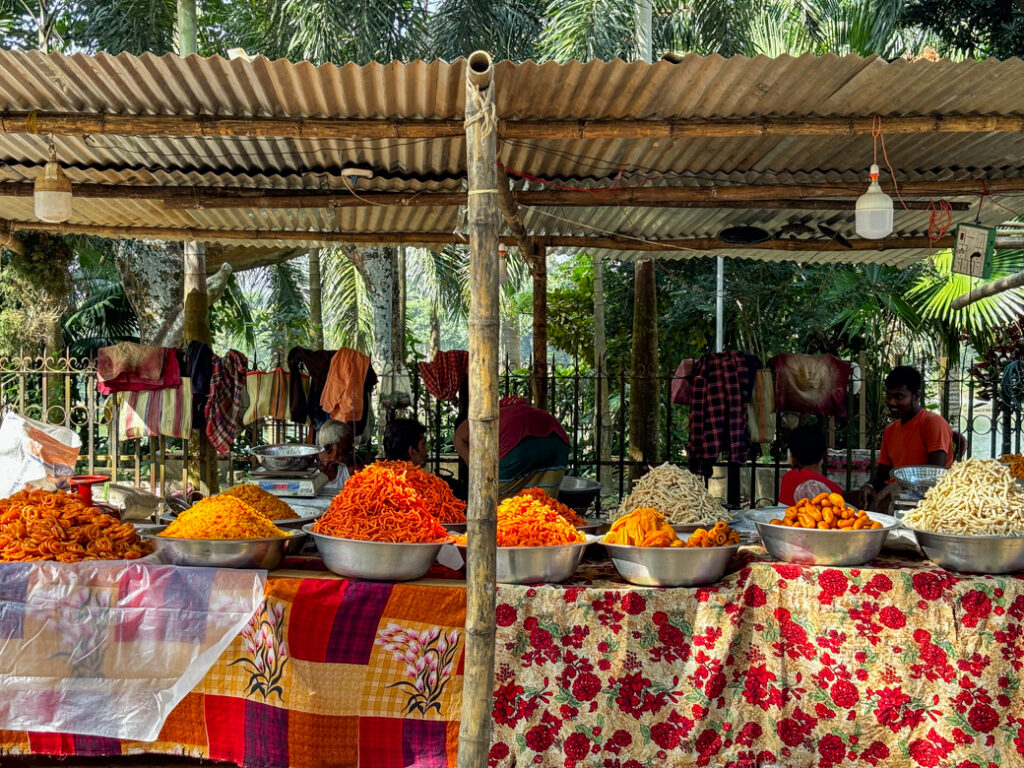
2. Sepahijala Wildlife Sanctuary and Zoological Park:
Afterwards, we went to the Sepahijala Wildlife Sanctuary and Zoological Park. It is, undoubtedly, one of the most popular tourist attractions of Tripura. Covering an area of 19 km, it is famous for being the home of Clouded Leopard, Spectacled Monkey, and Hoolock Gibbon. It is also the habitat of over 150 varieties of migratory birds.
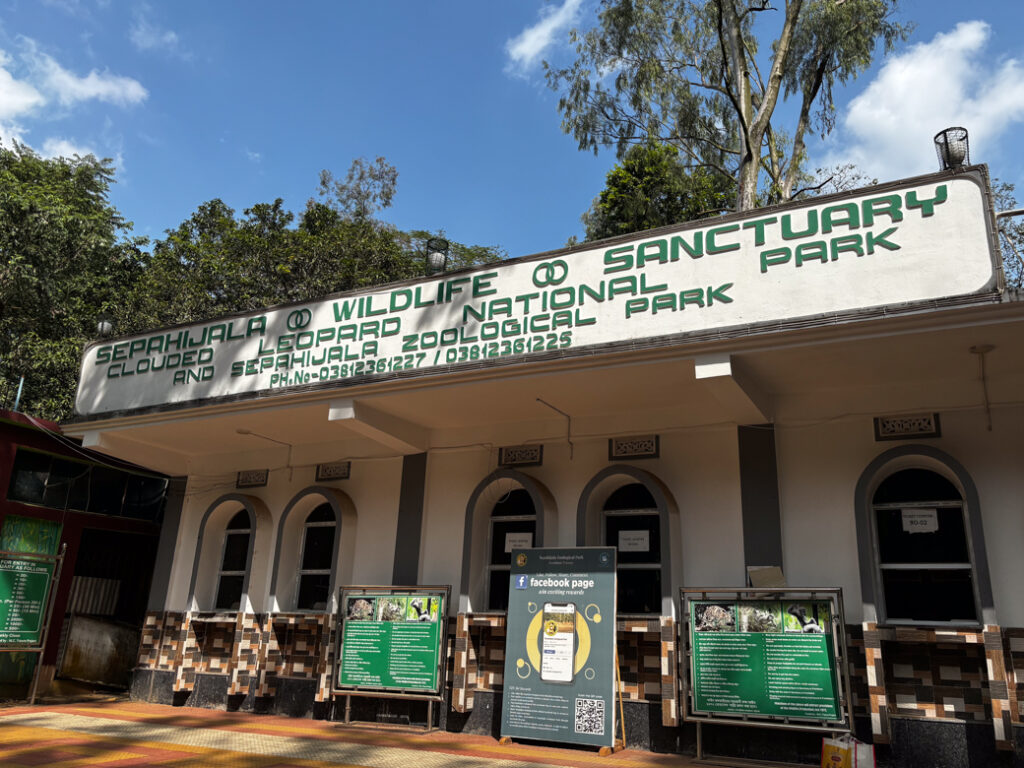

Things to remember while visiting the Sepahijala Sanctuary:
- The Sepahijala Wildlife Sanctuary remains open from 8 AM to 4 PM every day, except Friday.
- The entry fee for adults is INR 20 and for children below the age of 18 INR 10.
- Vehicles are allowed inside the sanctuary up to the gate of the Zoological Park. Entry fee for light vehicles is INR 50, auto INR 30, and bike/scooter INR 20.
- Still camera charge is INR 20, while the video camera is INR 2000.
- Tickets for entering the Zoological Park need to be purchased separately.
- Exploring the Zoological Park requires lots of walking. So, we advise wearing comfortable shoes and carrying drinking water and an umbrella.
- Toilet facilities are available at various points inside the Zoological Park.
3. Akhahura Integrated Check Post:
One of the top attractions of Tripura is the Akhahura Integrated Check Post. It was inaugurated back in 2013 and serves as the second-largest Indian trading centre with Bangladesh. Like the Wagah border in Amritsar, Akhahura also holds the ceremony of lowering the flags of the two countries by security personnel with a synchronised performance of the two sides.

It was really fascinating to watch the parades and lowering of the national flag by the security forces. Also, since it was Diwali, sweets and greetings were exchanged between the two countries. The visitors also participated in the Diwali celebrations along with the soldiers.
Things to remember while visiting the Akhahura Check Post:
- Visitors are allowed only on Saturdays and Sundays.
- The program starts at 5 PM.
- Reach the spot by 4 PM so that you can get a seat with an unobstructed view.
- You need to deposit your recognized identity cards before proceeding to the border. Also, you have to undergo body frisking as well for security reasons.
Day 3: Journey to Jampui Hills:
We started our third day by catching the early morning Jan Shatabdi Express for Dharmapur, which is the nearest rail station to Vanghmun in Jampui Hills. From Dharmanagar, we hired a cab for INR 2000 to reach Vanghmun. The road to Vanghmun is excellent, and it took us 2 hours to reach the popular hill station of Tripura.
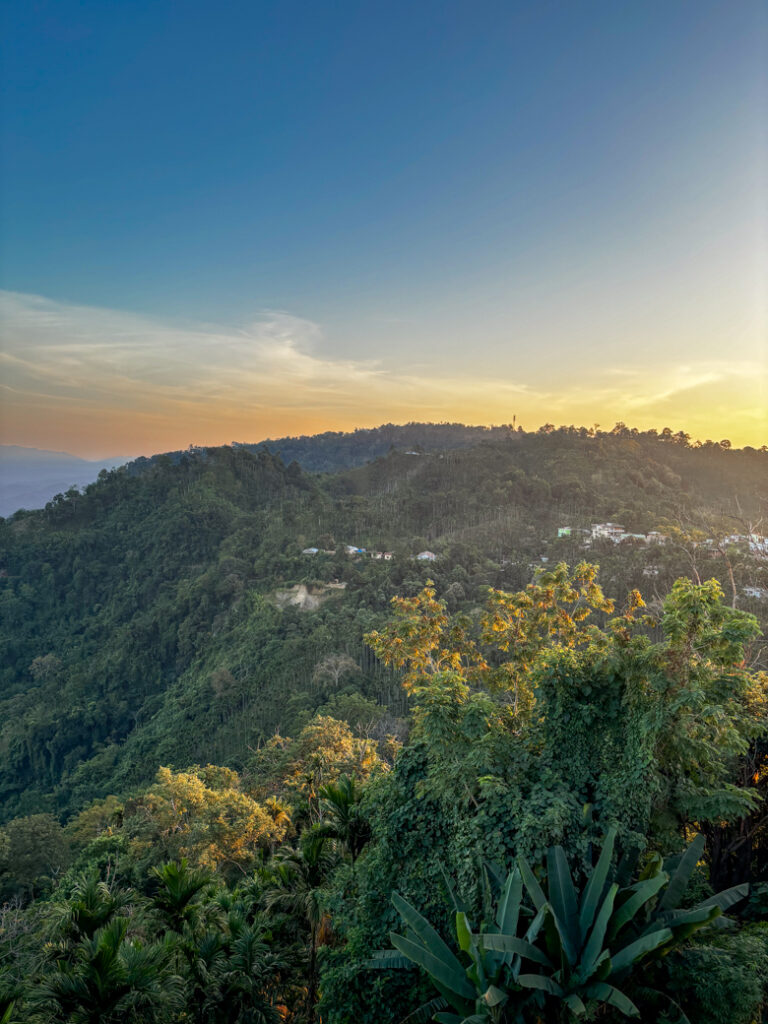
We checked in at Eden Tourist Lodge of Tripura Tourism. This is the only reliable option for accommodation in Jampui. We had booked a big 3-bedroom room for INR 1900 per night. Food is available in the lodge and you have to book your meal beforehand. The quality of food is dismal here. Too bad, there is no other option of dining in the vicinity.
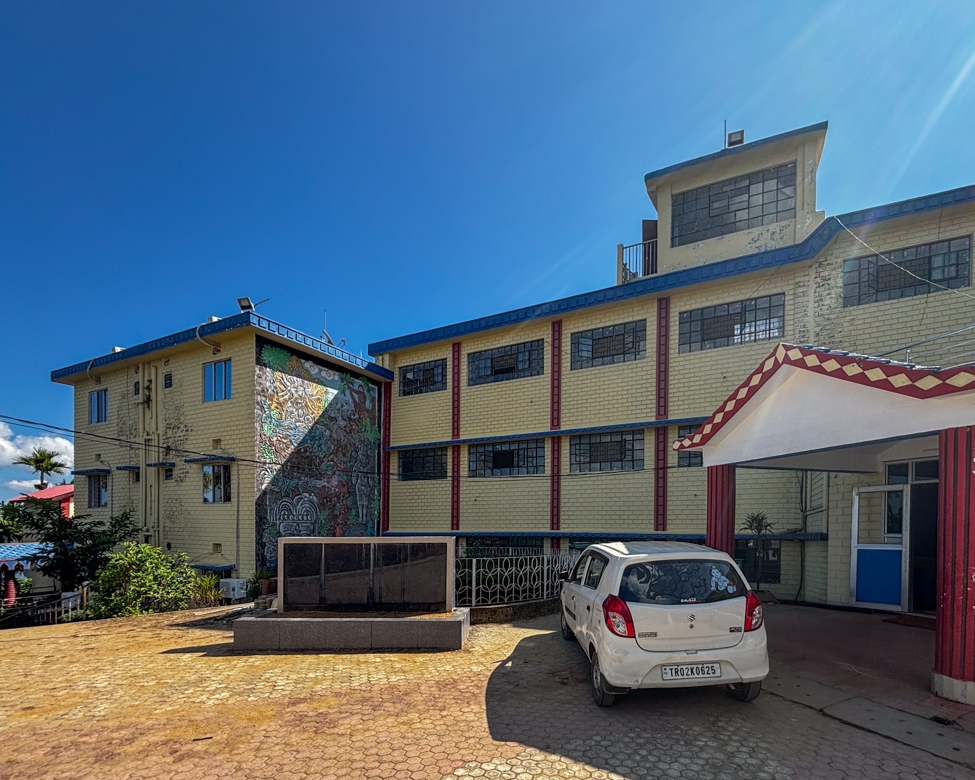
The Jampui Hills is a part of the Lushai Hills. Located in the North Tripura district, it comprises of 10 small villages of which Vanghmun is the headquarters. Known for its lush nature, orange orchards, and orchid bloom, Jampui Hills is a must-visit in Tripura. It is also renowned for amazing sunrise and sunset views.

Since the Eden Tourist Lodge has sunrise and sunset points inside the premises, we did not venture out. Both the sunrise and sunset were phenomenal.
Day 4: Ruins of Unakoti:
The next day, we left Vanghmun right after sunrise. Our destination was Unakoti, the enigmatic Saiva pilgrimage centre. Unakoti has been on our bucket list for a long time, and we finally managed to visit it. Previously, the road leading to Unakoti was nothing short of a nightmare. However, the scenario has drastically changed now, and the road has been repaired and widened.
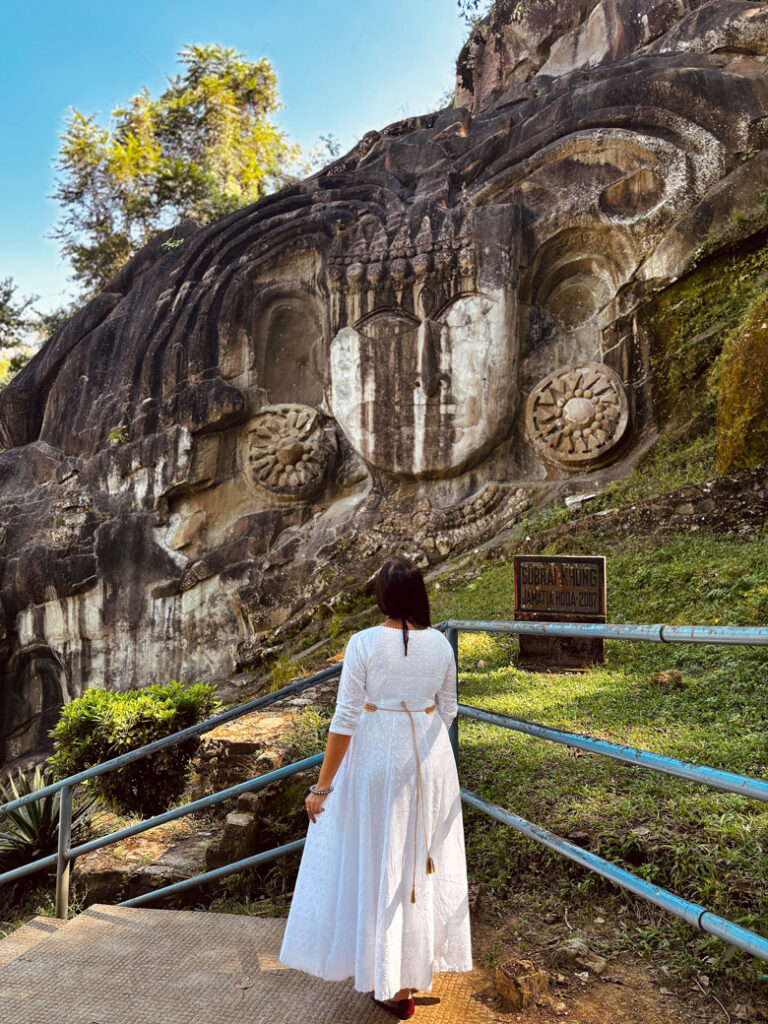
In Bengali, ‘Unakoti’ literally translates to ‘one less than a crore’. In the local Kokborok language, it is called ‘Subrai Khung’. The myth of Unakoti centres around Siva and his infamous rage. According to the legend, it was the meeting place of the 99,99,999 Gods and Goddesses along with Siva. The entourage decided to take a rest and spent one night here.
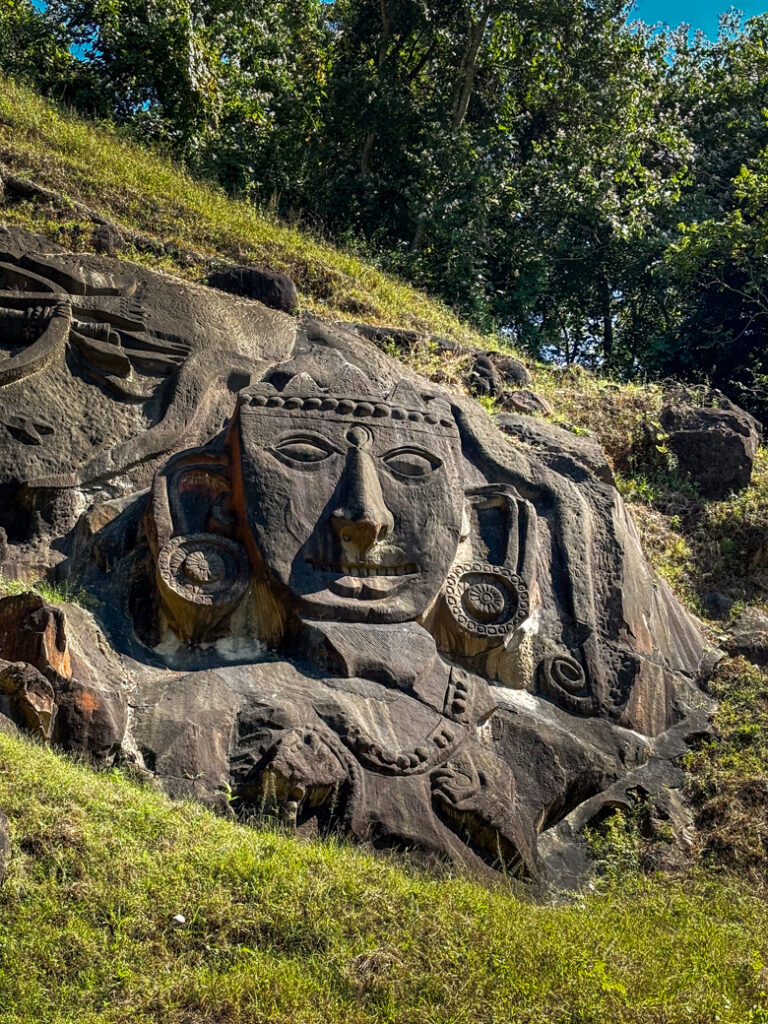
In turn, Siva explicitly directed them to wake up before dawn to resume their journey. However, only Siva was awake before sunrise while the rest of the retinue slept. Enraged by this disregard, Siva unleashed his fury, cursed them all to stone, and went on his way to Kashi alone. Thus, Unakoti became the abode of one less than a crore divine figures.

Unakoti is characterized by both colossal bas reliefs as also loose sculptures of various sizes. The most notable ones are Gangadhara Siva, Unakotisvara Kal Bhairava, Durga, Ganga, Siva – Parvati as Kirata – Kirati, Ganesha, and so on.

Things to remember while visiting Unakoti:
- No tickets are required for Unakoti. You just have to enrol your name and a few details in a register at the gate.
- Try visiting before noon, as exploring the ruins becomes difficult under the harsh sun.
- Wear comfortable shoes, as visiting Unakoti involves climbing countless steep stairs.
- Apart from two shacks selling green coconuts, packaged mineral water, soft drinks, chips, cakes, and biscuits, you will find no restaurants here.
- A toilet facility, baby care room, and mobile phone charging points are available here.
- Unakoti itself does not have hotels. You need to stay either at Kailashahar or Dharmanagar. At Kailashahar, the only feasible option is Tripura Tourism’s Unakoti Tourist Lodge. By contrast, Dharmanagar offers more choices of accommodation, such as Lokenath Guest House, Hotel J C Plaza, Hotel Panchabati, and Hotel Unakoti.

After we completed exploring Unakoti, we returned to Dharmanagar and boarded the Agartala Express at 1 PM. We reached Agartala at 4 PM and spent our night there.
Day 5: Neer Mahal and the temples of Udaipur:
1. Neer Mahal:
Our 5th day in Tripura was a bright sunny morning, perfect for visiting the resplendent Neer Mahal. Neer Mahal is one of the two water palaces found in India, the other being the Jal Mahal of Jaipur, Rajasthan. Though Rajasthan’s water palace is one of the top attractions of India and thousands of visitors throng every day to catch a glimpse of the Jal Mahal, Tripura’s Neer Mahal is the larger of the two.
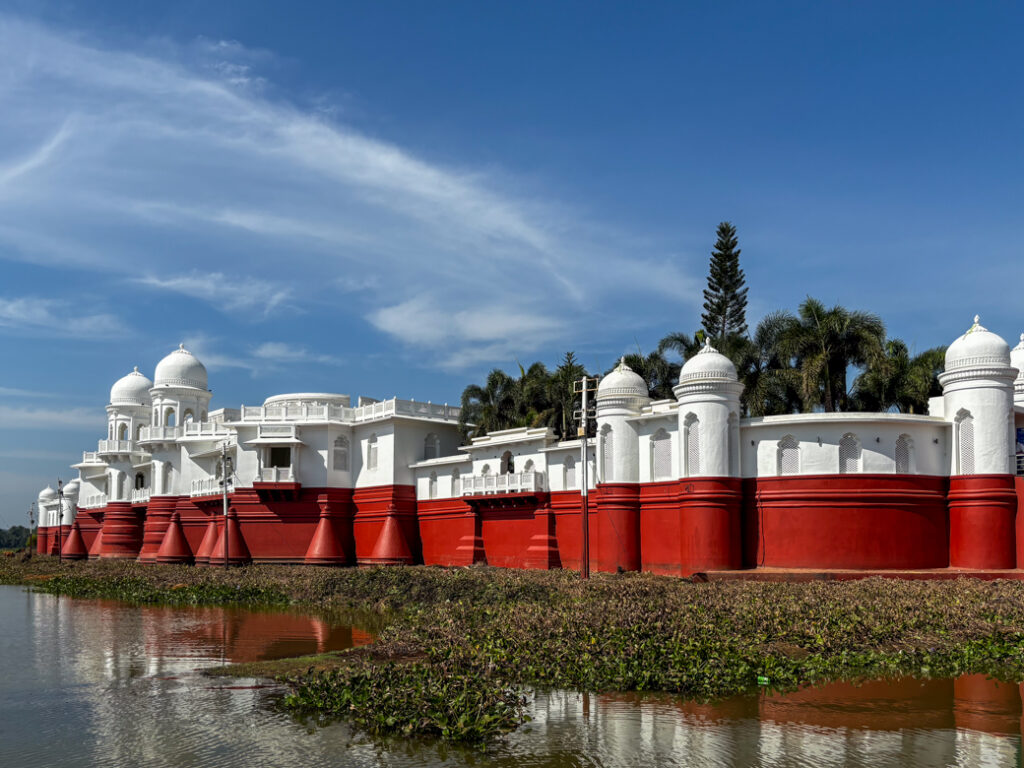
Neer Mahal translates to ‘water palace’. It was the brainchild of Maharaja Bir Bikram Kishore Manikya Debbarma, one of the most famous kings of Tripura. The Maharaja used Neer Mahal as a summer residence and a pleasure palace. Built amid the Rudra Sagar Lake, it was named ‘Neer Mahal’ by Nobel laureate Rabindranath Tagore.

Things to remember while visiting Neer Mahal:
- Since the Neer Mahal is situated right in the middle of a lake, you need to take a boat ride to reach the palace.
- The ticket counter for boats opens at 9 AM and closes at 5 in the evening.
- The regular boat fare per head is INR 50. Around 20 people are taken on a motorized boat.
- You can book a country boat for a maximum of 7 persons at INR 350.
- You can also reserve a special boat at INR 2500.
- The boat will take you to the gate of Neer Mahal. You will get 40 minutes to explore the palace. On the boat’s signal, you need to return ASAP.
- You will need to pay a parking charge of INR 50 near the boating ticket counter in case you are visiting by car or bike. After reaching the palace by boat, you have to pay INR 80 per head as the entrance fee.
- There are two options for accommodation here. First, you can stay at Sagar Mahal Tourist Lodge of Tripura Tourism. Secondly, you can opt for Polo Lake Resort.
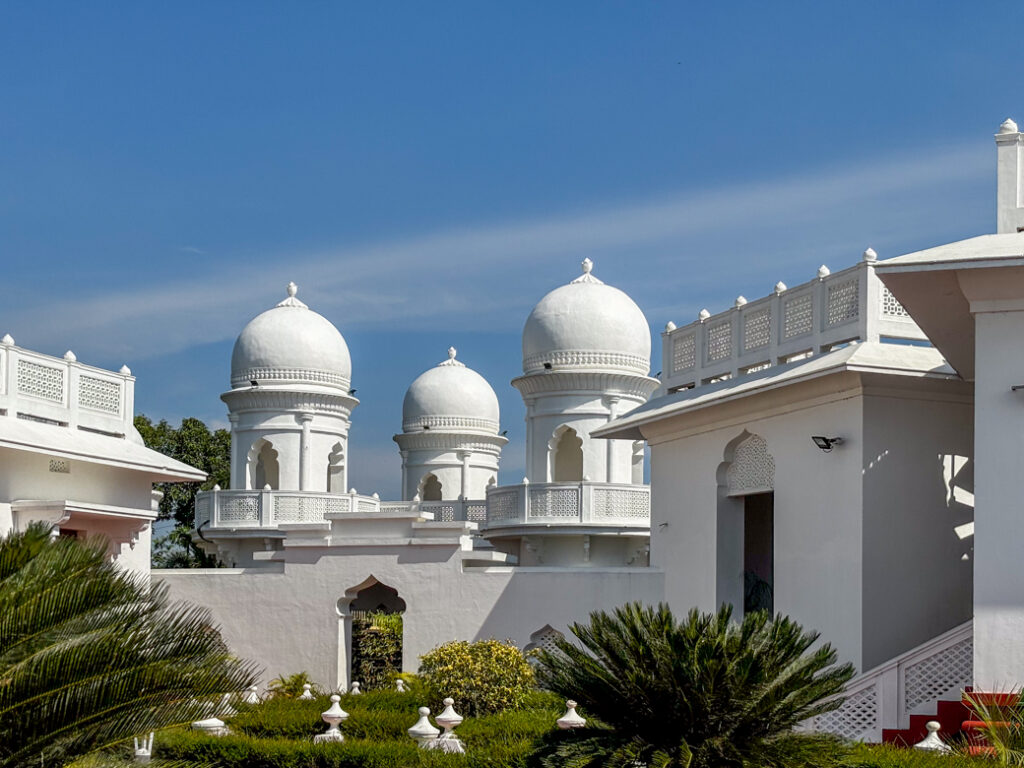
2. Temples of Udaipur:
Post lunch, we set out for the temples of Udaipur. First, we visited the Gunavati Group of Temples, located inside a dingy and busy lane of Udaipur. Three brick temples lie next to each other inside the premises. They were commissioned by Queen Gunavati, wife of Maharaja Govinda Manikya. The temples were built for the worship of Lord Vishnu. These temples somewhat resemble the ‘Chala’ type of temples found in West Bengal.

Next, we went to the Bhubaneshwari Temple, which has been immortalised by Rabindranath Tagore in his drama ‘Bisarjan’ and novel ‘Rajarshi’. Dedicated to Goddess Bhubaneshwari, it was built by Maharaja Govinda Manikya. It is constructed in the ‘Char Chala’ style of Bengal.

Lastly, we saw the Mahadev Temple or Mahadev Bari, which is revered as the home of Tripuresh Bhairava. This temple was commissioned by Maharaja Dhanya Manikya and built similarly to that of the Bhubaneshwari Temple.
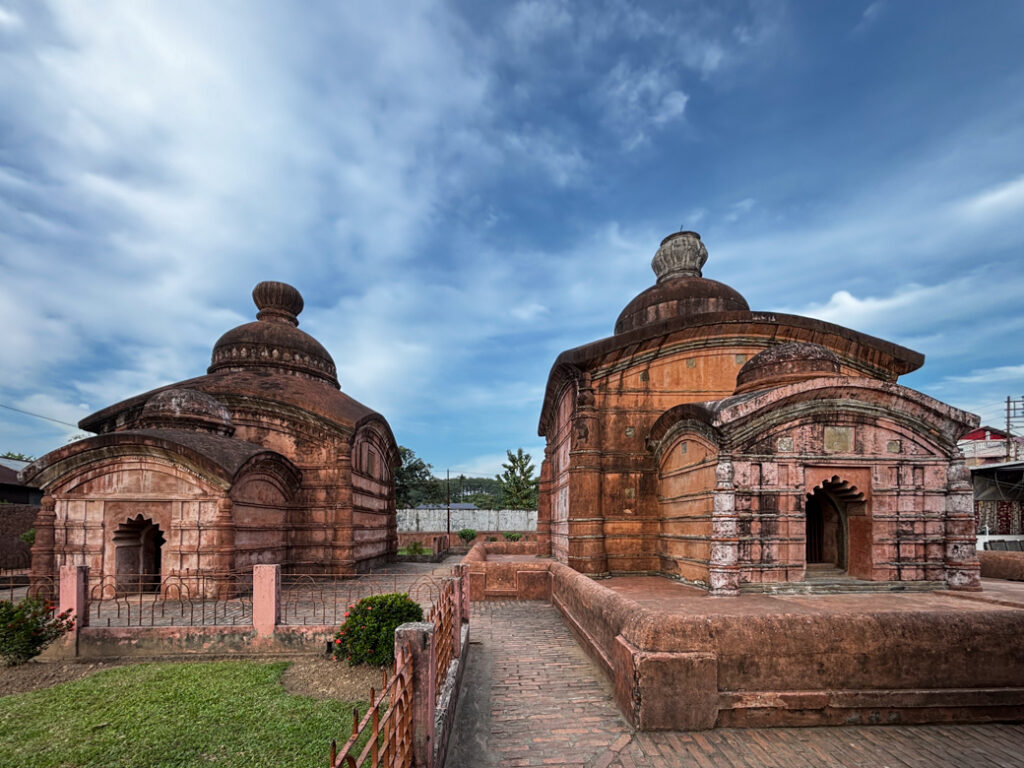
For the night, we stayed at Tripura Tourism’s Gunavati Yatri Niwas, which is situated just a stone’s throw away from the Tripura Sundari Temple. We had booked two rooms, each at INR 1500 each. The rooms were okay-ish. The hotel has a restaurant; however, the food is best to be avoided.
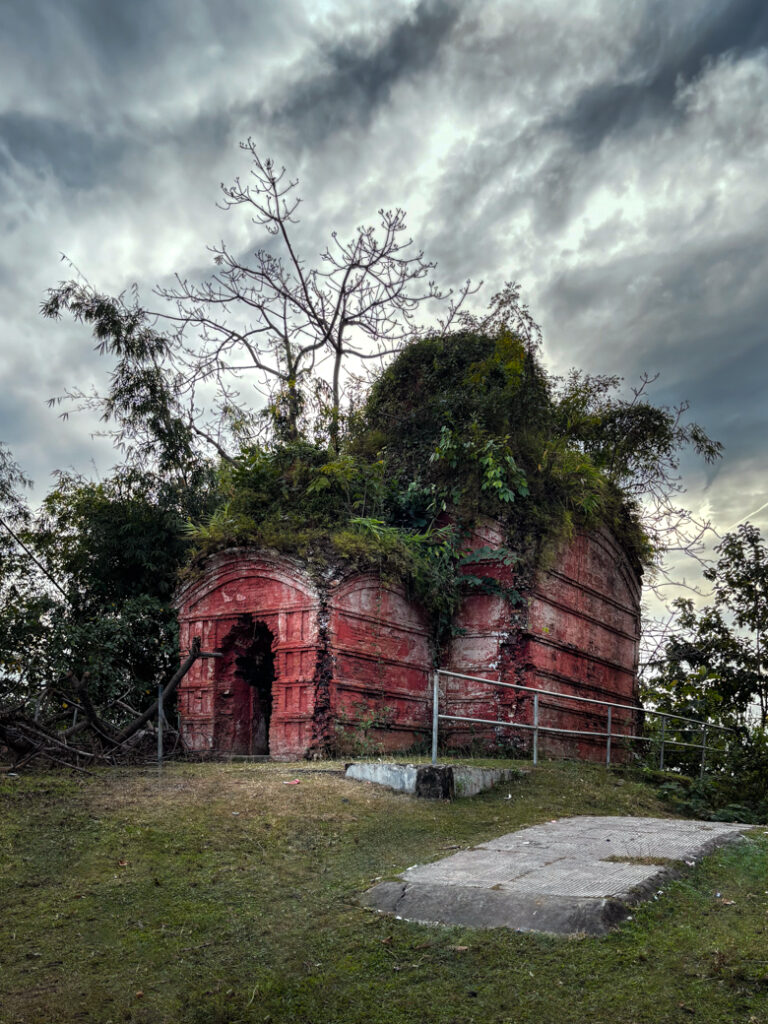
Day 6: Dumboor Lake and Chabimura:
We started our 6th day early as Dumboor Lake is quite far from Matabari. The lake is located 85 km from Matabari, and it takes around 3 hours to cover the distance. Also, the weather forecast was not favourable, and rain was on the cards. Hence, an early head-start to the day.
En route, we went to Tirthamukh, the awe-inspiring source of the Gomati River. Then, we hired a boat at INR 2000 to explore the Dumboor Lake and Visit the Narkel Kunja island. This huge lake has been created by the confluence of the Raima and Saima Rivers. It expands over a massive area of 41 sq. km. It resembles the shape of Siva’s Damru, and hence the name ‘Dumboor’ has been provided for this lake.
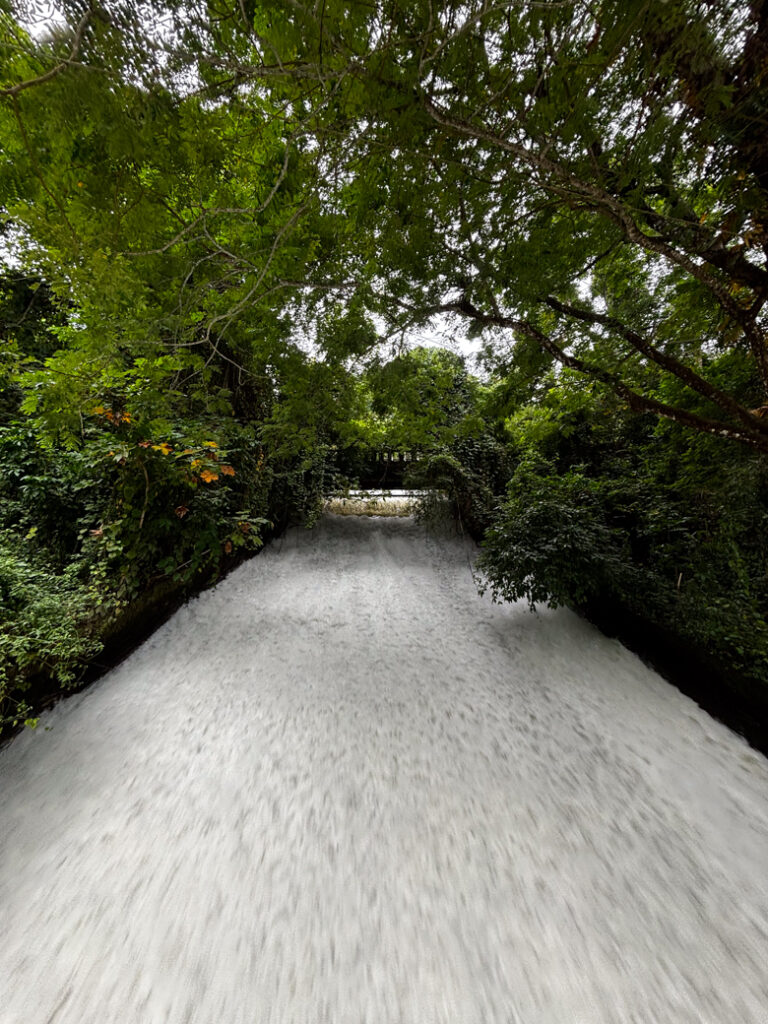
The boat ride to Narkel Kunja takes about 45 minutes. On this pleasant boat ride, we enjoyed the small villages lying on small islands and nature altogether.

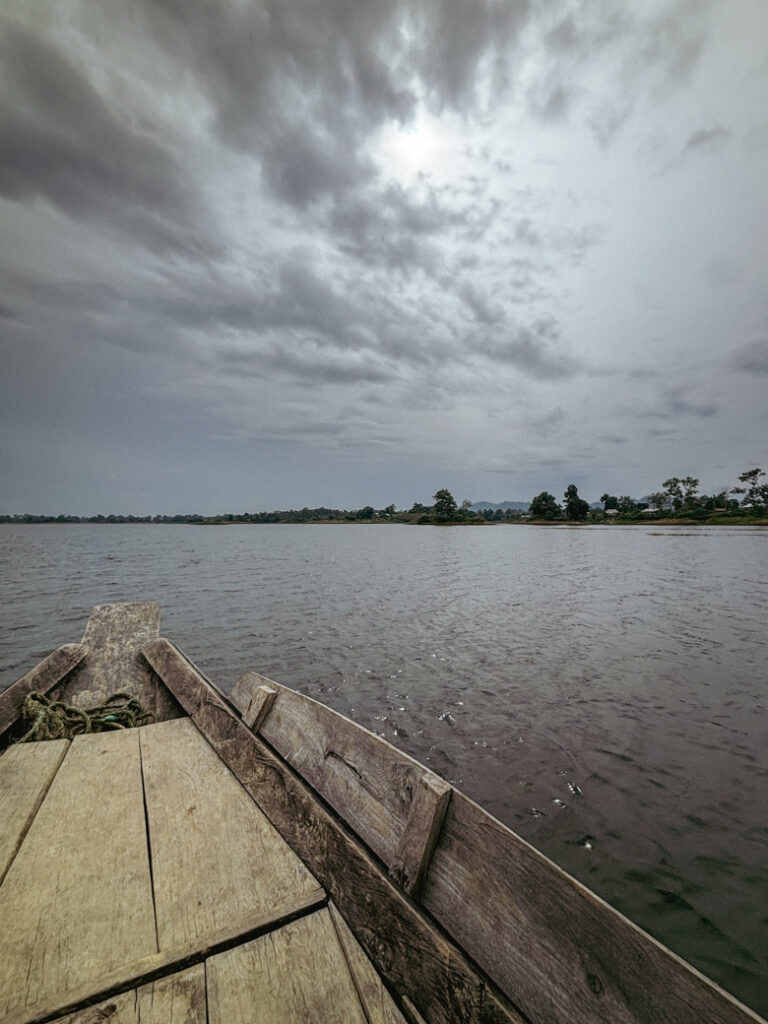
The Narkel Kunja Island has been developed by Tripura Tourism. Cottages have been built along with a restaurant. As we explored the island on foot, we munched on fried freshly caught fish and shrimps as well as Hog Plum or ‘Aamra’.
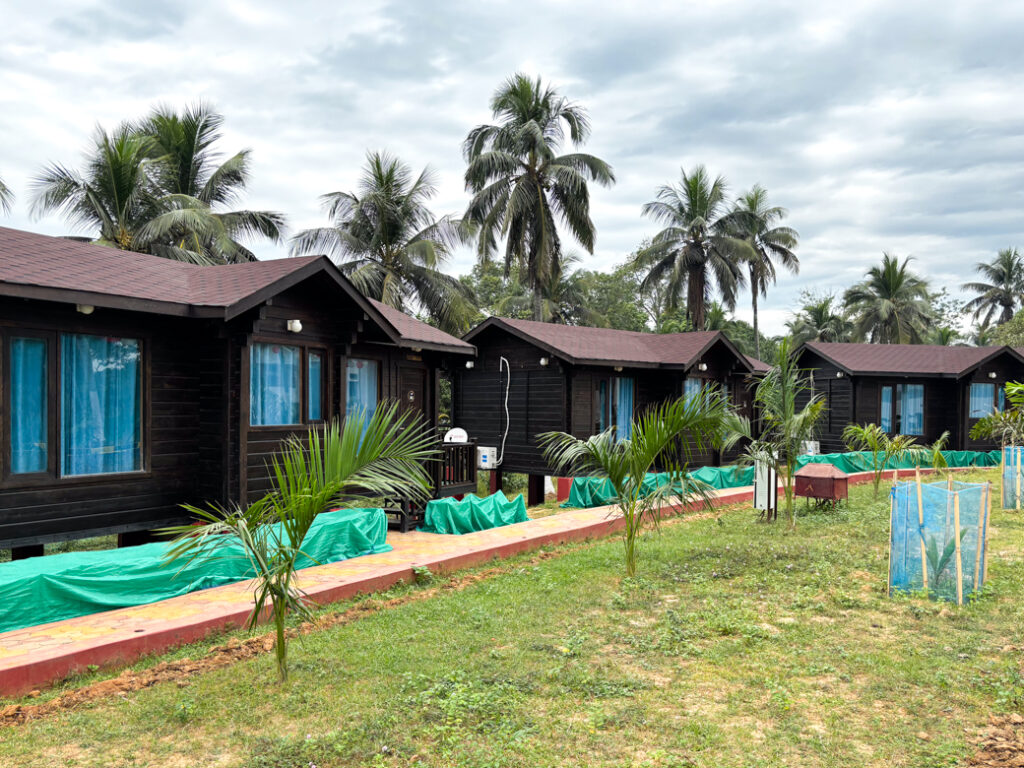

As the weather was taking a worse turn, we skipped lunch and headed straight towards Chabimura. Chabimura is home to a series of extraordinary rock-cut carvings of Hindu divinities, engraved on the hills that line the banks of the Gomati River. The word ‘Chabimura’ literally translates to ‘hill of pictures’ (in local dialect, ‘Mura’ means hill). This place is also called Devatamura or ‘hill of gods’. Chabimura is replete with panels of rock-cut sculptures on the steep slopes of the hills. The most stunning carvings belong to Mahisasuramardini, known locally as Chakrak Ma.
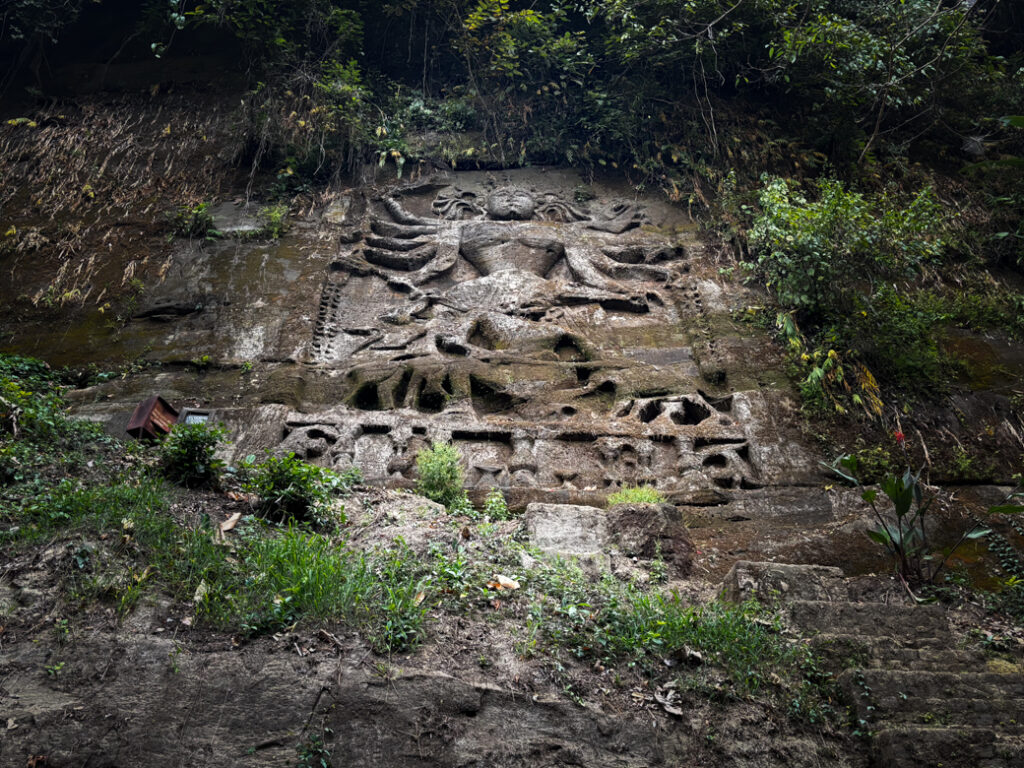
Things to remember while visiting Chabimura:
- Motor boats are the only option for braving the Gomati River in Chabimura. Boat rides are available till 4 PM.
- The ride costs INR 150 per head. The boats don’t leave until all the seats are booked. Generally, 10-15 passengers are accommodated in one motor boat.
- You can also hire an entire boat for yourself. This will cost you INR 3000.
- There are no hotels for spending the night at Chabimura. You can book a stay at Sagarika Parjatan Niwas near the Fatik Sagar Lake in Amarpur.

Day 7: Darsan of Tripura Sundari:
Our last day at Tripura started with an incessant cyclonic rainfall. A gale accompanied the heavy rainfall, and it seemed impossible to go out. We had initially planned to visit the Tripura Sundari Temple at 5 AM. However, our plan got delayed owing to the non-stop rain. At around 7, the rain slowed down a bit. Armed with umbrellas, we braved the rain as well as the strong wind. The road leading to the temple was flooded, and there was hardly any soul out.
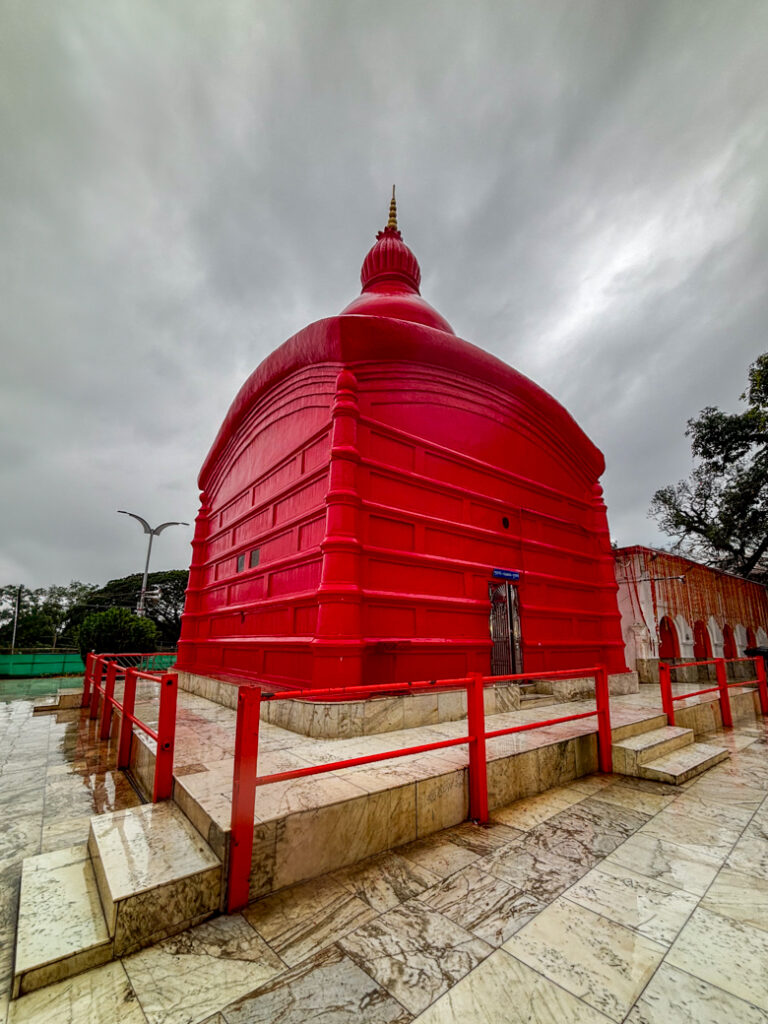
The temple, which usually bustles with throngs of pilgrims, was forlorn. We were the sole visitors. Consequently, we had an undeterred darshan of Goddess Tripura Sundari and offered Puja at ease. Pertinent to mention here that, Tripura Sundari Temple is one of the 51 Shakti Peethas and Sati’s right foot had fallen here. Hence, this temple is regarded as one of the holiest temples not only in Tripura but also in India.

Things to remember while visiting Tripura Sundari Temple:
- The temple opens at 4 AM and closes at 10 PM.
- The temple remains closed for an hour after the Goddess is served ‘Anna Bhoga’ at 1-30 PM.
- Try visiting as early as possible.
- Try avoiding a visit to the temple during the Kali Puja, as countless people visit Mata Bari during this festival.
- The ‘pera’ of Tripura Sundari Temple is delicious. There are numerous ‘pera’ shops lining the vicinity of the temple.

Important FAQs:
1. How can I reach Tripura?
By train: You can catch 02501 Kolkata – Agartala Special Express from Kolkata station and 13173 Kanchanjangha Express from Sealdah station. The journey takes around 32 hours to complete.
By air: Multiple flights fly to Agartala from Kolkata daily. It takes less than an hour to travel by air.
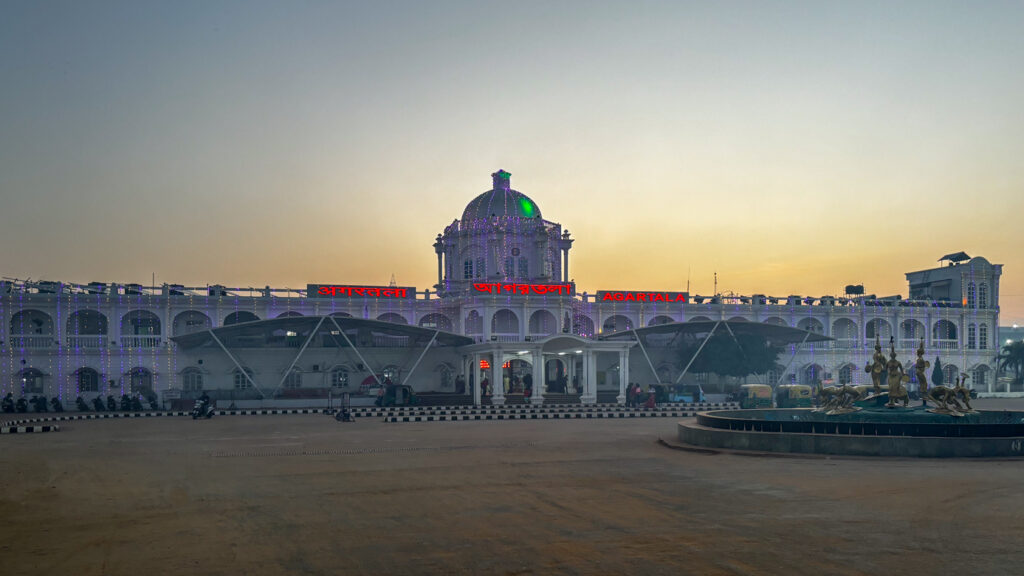
2. How can I travel inside Tripura?
Tripura itself has great rail connectivity. You can avail trains to travel to important places such as Udaipur, Dharmanagar, and Kailashahar.
3. Where can I stay in Tripura?
At Agartala: Hotel Tripura Sundari, Hotel Sonar Tori, and Hotel Polo Towers.
At Vanghmun, Jampui Hills: Eden Tourist Lodge.
At Dharmanagar: Lokenath Guest House, Hotel JC Palace, Hotel Panchabati.
At Unakoti: Unakoti Tourist Lodge, Kailashahar.
At Udaipur: Gunavati Yatri Niwas, Mata Bari.
At Neer Mahal: Sagar Mahal Tourist Lodge and Polo Lake Resort.
At Amarpur: Sagarika Paryatan Niwas.
At Dumboor Lake: Narikel Kunja Resort.

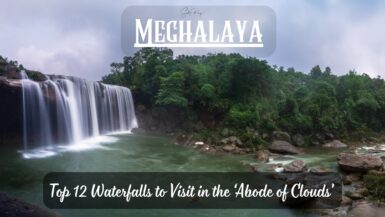
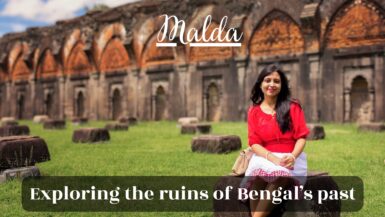

What are the Scientific explanation or archeological explanation behind the wonderful formation of Unakoti and Chabimura?? I am little bit curious for this